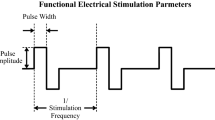Abstract.
The relationship between tactile hypoesthesia and precision grip force was examined using compression of the median nerve in healthy adults. Hypoesthesia was graded by varying the pressure that an external clamp exerted over the carpal canal. Electrical stimulation of the median nerve in the forearm evoked a compound sensory nerve action potential (SNAP) that we recorded from the digital nerves of the index finger. Clamp pressure was varied to achieve SNAPs that were 75%, 50%, and 25% of precompression amplitude (100%). Grip force and tactile sensibility (Semmes-Weinstein filaments, cotton wisps, sharp/dull) did not change in parallel with reductions of the SNAP. Subjects reported paresthesias at the thumb and index finger at 75% SNAP. Tactile pressure thresholds increased to the clinical range of 'diminished light touch', but subjects detected cotton wisps stroked along the finger. At 75% SNAP grip force did not change compared to 100% SNAP. Simple prehension can proceed efficiently despite these modest reductions in tactile signals. At 50% SNAP the digits remained sensate, but were reported to feel "thick, like cardboard". No subject could detect cotton wisps and tactile thresholds increased by one filament. Sharp/dull distinctions remained. Grip force increased by 55% compared to grip force at SNAPs of 100% and 75%. There were no changes in skin slipperiness, so the increased grip force represented elevated 'safety margin' (grip force exceeding that needed to prevent slip). At 25% SNAP subjects described the skin innervated by the median nerve as feeling "numb", but grip force increased little compared to 50% SNAP. Grip force continued to reflect changes in grip surface friction, and mechanical transients from setting the object on the table triggered coordinated reductions in grip force. We suspect that the loss of information from SA I and FA I, but not FA II, tactile afferents provoked the increased grip force.
Similar content being viewed by others
Author information
Authors and Affiliations
Additional information
Electronic Publication
Rights and permissions
About this article
Cite this article
Cole, K.J., Steyers, C.M. & Graybill, E.K. The effects of graded compression of the median nerve in the carpal canal on grip force. Exp Brain Res 148, 150–157 (2003). https://doi.org/10.1007/s00221-002-1283-6
Received:
Accepted:
Issue Date:
DOI: https://doi.org/10.1007/s00221-002-1283-6




